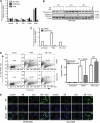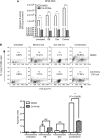Potentiation of apoptosis by histone deacetylase inhibitors and doxorubicin combination: cytoplasmic cathepsin B as a mediator of apoptosis in multiple myeloma
- PMID: 21364585
- PMCID: PMC3065279
- DOI: 10.1038/bjc.2011.42
Potentiation of apoptosis by histone deacetylase inhibitors and doxorubicin combination: cytoplasmic cathepsin B as a mediator of apoptosis in multiple myeloma
Abstract
Background: Although inhibitors of histone deacetylase inhibitors (HDACis) in combination with genotoxins potentiate apoptosis, the role of proteases other than caspases in this process remained elusive. Therefore, we examined the potentiation of apoptosis and related mechanisms of HDACis and doxorubicin combination in a panel of myeloma cell lines and in 25 primary myelomas.
Results: At IC(50) concentrations, sodium butyrate (an HDACi) or doxorubicin alone caused little apoptosis. However, their combination potentiated apoptosis and synergistically reduced the viability of myeloma cells independent of p53 and caspase 3-7 activation. Potentiated apoptosis correlated with nuclear translocation of apoptosis-inducing factor, suggesting the induction of caspase 3- and 7-independent pathways. Consistent with this, butyrate and doxorubicin combination significantly increased the activity of cytoplasmic cathepsin B. Inhibition of cathepsin B either with a small-molecule inhibitor or downregulation with a siRNA reversed butyrate- and doxorubicin-potentiated apoptosis. Finally, ex vivo, clinically relevant concentrations of butyrate or SAHA (suberoylanilide hydroxamic acid, vorinostat, an HDACi in clinical testing) in combination with doxorubicin significantly (P<0.0001) reduced the survival of primary myeloma cells.
Conclusions: Cathepsin B has a prominent function in mediating apoptosis potentiated by HDACi and doxorubicin combinations in myeloma. Our results support a molecular model of lysosomal-mitochondrial crosstalk in HDACi- and doxorubicin-potentiated apoptosis through the activation of cathepsin B.
Conflict of interest statement
The authors declare no conflict of interest.
Figures





Similar articles
-
The histone deacetylase inhibitor LBH589 enhances the anti-myeloma effects of chemotherapy in vitro and in vivo.Leuk Res. 2011 Mar;35(3):373-9. doi: 10.1016/j.leukres.2010.06.026. Epub 2010 Jul 21. Leuk Res. 2011. PMID: 20650529
-
Molecular sequelae of histone deacetylase inhibition in human retinoblastoma cell lines: clinical implications.Invest Ophthalmol Vis Sci. 2009 Sep;50(9):4072-9. doi: 10.1167/iovs.09-3517. Epub 2009 Apr 22. Invest Ophthalmol Vis Sci. 2009. PMID: 19387079
-
Synergistic action of the novel HSP90 inhibitor NVP-AUY922 with histone deacetylase inhibitors, melphalan, or doxorubicin in multiple myeloma.Eur J Haematol. 2010 Apr;84(4):337-44. doi: 10.1111/j.1600-0609.2009.01403.x. Epub 2009 Dec 17. Eur J Haematol. 2010. PMID: 20028416
-
New insights into the treatment of multiple myeloma with histone deacetylase inhibitors.Curr Pharm Des. 2013;19(4):734-44. Curr Pharm Des. 2013. PMID: 23016853 Free PMC article. Review.
-
Exploring the role of histone deacetylase and histone deacetylase inhibitors in the context of multiple myeloma: mechanisms, therapeutic implications, and future perspectives.Exp Hematol Oncol. 2024 Apr 23;13(1):45. doi: 10.1186/s40164-024-00507-5. Exp Hematol Oncol. 2024. PMID: 38654286 Free PMC article. Review.
Cited by
-
Rutin and orlistat produce antitumor effects via antioxidant and apoptotic actions.Naunyn Schmiedebergs Arch Pharmacol. 2019 Feb;392(2):165-175. doi: 10.1007/s00210-018-1579-0. Epub 2018 Nov 21. Naunyn Schmiedebergs Arch Pharmacol. 2019. PMID: 30465055
-
Cysteinyl cathepsins in cardiovascular diseases.Biochim Biophys Acta Proteins Proteom. 2020 Apr;1868(4):140360. doi: 10.1016/j.bbapap.2020.140360. Epub 2020 Jan 9. Biochim Biophys Acta Proteins Proteom. 2020. PMID: 31926332 Free PMC article. Review.
-
Monitoring Tumor Response After Histone Deacetylase Inhibitor Treatment Using 3'-Deoxy-3'-[18F]-fluorothymidine PET.Mol Imaging Biol. 2015 Jun;17(3):394-402. doi: 10.1007/s11307-014-0774-8. Mol Imaging Biol. 2015. PMID: 25323103
-
Epigenetic modulating agents as a new therapeutic approach in multiple myeloma.Cancers (Basel). 2013 Apr 15;5(2):430-61. doi: 10.3390/cancers5020430. Cancers (Basel). 2013. PMID: 24216985 Free PMC article.
-
Comparison of Chemotherapy Combined With Chidamide Versus Chemotherapy in the Frontline Treatment for Peripheral T-Cell Lymphoma.Front Immunol. 2022 Feb 2;13:835103. doi: 10.3389/fimmu.2022.835103. eCollection 2022. Front Immunol. 2022. PMID: 35185926 Free PMC article.
References
-
- Badros A, Burger AM, Philip S, Niesvizky R, Kolla SS, Goloubeva O, Harris C, Zwiebel J, Wright JJ, Espinoza-Delgado I, Baer MR, Holleran JL, Egorin MJ, Grant S (2009) Phase I study of vorinostat in combination with bortezomib for relapsed and refractory multiple myeloma. Clin Cancer Res 15(16): 5250–5257 - PMC - PubMed
-
- Bae SI, Cheriyath V, Jacobs BS, Reu FJ, Borden EC (2008) Reversal of methylation silencing of Apo2L/TRAIL receptor 1 (DR4) expression overcomes resistance of SK-MEL-3 and SK-MEL-28 melanoma cells to interferons (IFNs) or Apo2L/TRAIL. Oncogene 27(4): 490–498 - PubMed
-
- Bergsagel PL, Kuehl WM (2001) Chromosome translocations in multiple myeloma. Oncogene 20(40): 5611–5622 - PubMed
-
- Bidere N, Lorenzo HK, Carmona S, Laforge M, Harper F, Dumont C, Senik A (2003) Cathepsin D triggers Bax activation, resulting in selective apoptosis-inducing factor (AIF) relocation in T lymphocytes entering the early commitment phase to apoptosis. J Biol Chem 278(33): 31401–31411 - PubMed
Publication types
MeSH terms
Substances
LinkOut - more resources
Full Text Sources
Medical
Research Materials
Miscellaneous

